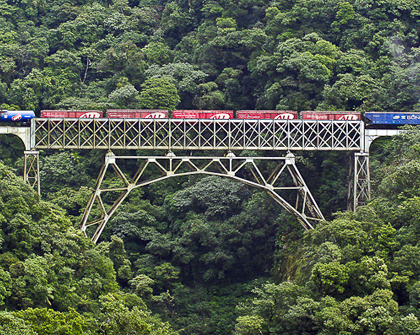The development of ports and waterways in South America is of vital importance to improving the region’s competitiveness through lower transportation costs. It is also key to promoting sustainable development using modes of transportation that are more efficient in environmental terms. INTAL provided technical support for the workshop that was held on this topic within the framework of COSIPLAN.
Integration through ports and waterways is one of the main areas of work for promoting connectivity within South America. As a result, the Workshop on South American Integration through Ports and Waterways was incorporated into the COSIPLAN-IIRSA Work Plan 2015[1] and was held on October 14 and 15 in Brasilia, Brazil.
Those at the meeting emphasized the potential of waterways, which are as much a part of the logistics system as all other modes of transport. As a result, they agreed to work on waterway sector projects within the COSIPLAN Priority Project Agenda (API). These are the following:
API 3: Northeastern Access to the Amazon River (in Spanish) (Brazil, Colombia, Ecuador, and Peru)
- Estimated investment: US$ 61,759,000
- Type of finance: Public
- Project stage: Execution
This project seeks to take advantage of the complementarities of the different natural regions of Ecuador, Colombia, Peru, and Brazil by linking the coastal and Andean areas of Ecuador and Colombia with the Amazon in general. The purpose of the bimodal corridors, which will become operational when the waterways and corresponding river terminals are opened, is to make the city of Manaus a commercial destination, without losing sight of the possibility of connecting to overseas markets.
Project technical specifications: (i) construction of a 150-ha logistics transfer center; (ii) improvement of navigation conditions for 1,200 km of waterways; (iii) renovation and/or construction of 12 docks; (vi) construction of a river port.
API 17: Improvement of Navigation Conditions on the Rivers of the Plata Basin (in Spanish) (Argentina, Bolivia, Brazil, Paraguay, and Uruguay)
- Estimated investment: US$ 1,169,998,216
- Type of finance: Public
- Project stage: Execution
Improvements to waterway navigation conditions will lead to significant reductions in transportation costs for internal trade flows between regions, and also for extra-regional trade, thus contributing to the economic integration of the region and to strengthening its sustainable development. This will make products from the region more competitive, notably for those areas that are furthest from seaports.
Project technical specifications: (i) improvement of navigation conditions for 4,708.3 km of waterways; (ii) implementation of a water level prediction system.
API 27: Multimodal Transportation in the Laguna Merín and Lagoa dos Patos System (Brazil and Uruguay)
- Estimated investment: US$ 38,200,000
- Type of finance: Public/private
- Project stage: Execution
This project will improve connectivity between eastern Uruguay and southern Brazil by making the waterways of the Laguna Merín and Lagoa dos Patos system fully navigable. The construction of Highway BR-471/RS (Chuí-Pelotas) in the 1970s led to the closure of these waterways. Reinstating them as transportation routes will allow larger volumes of cargo to be transported, thus reducing freight and infrastructure maintenance costs, easing congestion at border crossings, while reducing the environmental impact of greenhouse gas emissions, noise pollution, and road accidents.
Project technical specifications: i) dredging, improvements to waterway corridors and complementary works for the two lakes and their tributaries (includes dredging, installation of signs, buoy markers, and aids to navigation, and cartographic and hydrographic surveys); (ii) construction of two river port terminals.
Within the portfolio, there are currently 113 projects from the transportation sector, within the river and sea transportation sub-sectors, for an estimated investment of approximately US$ 14 billion.
Table 1. Projects from the river and sea sub-sectors by type of construction work Number of projects and estimated investment
[1] The Work Plan 2015 was passed at the5th Ordinary Meeting of COSIPLAN Ministers.





